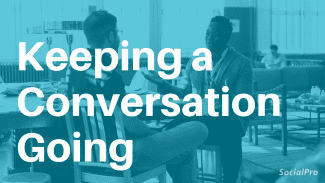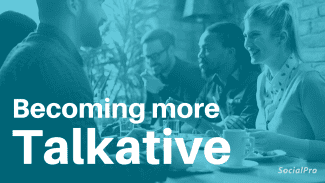“I try to spark up conversations with people at work, but it always feels forced. It’s so awkward that I dread bumping into people in the hallway or making small talk before a meeting. How can I make my conversations feel more natural?”
When almost every conversation feels forced, talking to people can be so uncomfortable that it feels impossible to meet people, make friends and have a healthy social life. Luckily, there are many simple strategies that can help conversations flow more smoothly and naturally, allowing you to enjoy them instead of dreading them.
1. Ask questions to get the other person talking
Asking questions is a great way to shift the focus off of yourself and alleviate the pressure to say the “right” thing or come up with an interesting topic. Open-ended questions invite more dialogue than closed-ended ones that can be answered in one word, making them versatile for first dates and even casual conversations with coworkers or friends. The more the other person participates in the conversation, the less “forced” it will feel.
For instance, instead of asking, “Did you have a good weekend?”, try asking an open-ended question like, “What did you do over the weekend?”. Open questions encourage longer, more detailed answers. Because they also demonstrate an interest in the other person, open-ended questions also generate feelings of closeness and trust.[1]
2. Master the art of active listening
The best conversationalists aren’t just great speakers, but also great listeners. Active listening is a way to demonstrate your interest and understanding of what someone is saying by using specific skills and phrases. Active listening is a secret technique therapists use to build a strong relationship with their clients and is a highly effective way to get people to trust you, like you, and open up.[1]
Active listening includes four skills:[1]
1. Open-ended questions: Questions that can’t be answered in one word.
Example: “What did you think about that meeting?”
2. Affirmations: Statements that validate someone’s feelings, thoughts or experiences.
Example: “It sounds like you had a blast.”
3. Reflections: Repeating part of what the other person said to confirm it.
Example: “Just to confirm – you want to change the policy to include 10 days of sick leave, 2 weeks of vacation days, and 3 floating holidays.”
4. Summaries: Tying together a summary of what the other person said.
Example: “Even though you have more flexibility because you’re working from home, you feel like you have less time for yourself.”
3. Think out loud
When conversations feel forced, it might be because you are heavily editing and censoring what you say instead of speaking freely. Research shows that this mental habit can actually worsen social anxiety, making you feel more self-conscious and insecure.[2] Instead of trying to find something to talk about, try saying what’s already on your mind.
If you are thinking about what to do this weekend, remembering a funny show you saw, or wondering what the weather will be like this afternoon, say it out loud. By thinking out loud, you invite others to get to know you better and may even make them feel more comfortable opening up to you. Thinking out loud can sometimes lead to interesting and unexpected conversations.
4. Speak slowly, pause, and allow silence
Pauses and silences are social cues that signal it is the other person’s turn to talk. Without them, conversations can become one-sided.[3] By becoming more comfortable with silence, your conversations feel less forced. When you slow down and take a pause, you give the other person a chance to speak and help the conversation become more balanced.
When you feel nervous, you might feel an urge to fill any awkward pauses but try to resist acting on it. Instead, wait a few moments and see where the conversation goes. This slows the conversation down to a more comfortable pace, buys you time to think, and allows the other person time to speak.
5. Find topics that spark interest and enthusiasm
You don’t usually need to “force” people to talk about things they like, so try finding interesting things to talk about. This might be something they know a lot about, a relationship that is important to them, or an activity they enjoy. For example, asking someone about their kids, last vacation, or what books or shows they like is a great way to find a topic they want to talk about.[4]
When you hit upon a topic that someone is interested in, you can usually see their body language change. They may smile, look excited, lean forward, or seem eager to speak. It’s harder to gauge interest when conversations happen online or via text, but longer responses, exclamation points, and emojis can indicate interest and enthusiasm.
6. Go beyond small talk
Most small talk stays within a safe zone, with exchanges like, “How are you?” and “Good, and you?” or, “It’s so nice outside,” followed by, “Yes it is!”. Small talk isn’t bad, but it can trap you into having the same short interaction with people over and over again. Because many people use these exchanges to greet someone and be polite, small talk isn’t the way to start a deeper conversation.
You can always start with small talk and then use another open-ended question, observation, or comment to go a little deeper. For example, if you are on a first date, start by asking them where they’re from or what they do for work, but then follow up with more specific questions about what they like about their job or what they miss about their hometown. By asking the right questions, you can often move beyond small talk to a more personal, in-depth conversation.[4]
7. Avoid controversial or sensitive topics
When you accidentally broach a topic that is controversial, sensitive, or too personal, things can start to feel tense and forced. Religion, politics, and even casual comments about current events can quickly shut down a conversation. Even innocent questions like, “Do you have kids?” can offend someone who may be struggling with infertility, had a miscarriage, or simply has chosen not to have children.
Asking broad or general questions is a good tactic because it allows the other person to freely choose what and how much they share. For example, asking, “How is the new job going?” or, “Did you do anything fun over the weekend?” gives people a chance to share things on their own terms while avoiding making them uncomfortable.
8. Let yourself take a raincheck
If you feel obligated to talk to people you don’t like or when you aren’t in the mood, your conversations are bound to feel forced. Everyone has times when they don’t feel like talking or would prefer to be alone. Unless there is a pressing need to have a conversation now, it’s OK to give yourself permission to take a rain check when you’re not in the mood to talk.
Most of the time, friends, family, and even coworkers will understand if you don’t feel like hanging out. It’s even OK to make up an excuse if you are worried about offending someone. Just make sure you don’t make this a habit because frequent cancelations can damage relationships and can even become an unhealthy avoidance tactic for people with social anxiety.[2]
9. Be curious and open-minded
When you feel nervous and self-conscious, you are often stuck in your head judging yourself, worrying, and ruminating. These mental habits feed into insecurities and anxiety while also keeping you distracted.[2] You can reverse self-consciousness by focusing your full attention on the other person rather than on yourself or your thoughts.
According to research, people who adopted a curious mindset reported feeling less anxious, less insecure, and more able to enjoy their conversations with people.[5] When you find yourself getting too wrapped up in your thoughts, get out of your head by becoming curious about the other person. Immerse yourself in the conversation by using active listening to focus fully on what they are saying.
10. Know when to end the conversation
Long conversations aren’t always better, especially when they start to feel forced. If you sense that the other person wants to leave, is disinterested, or doesn’t seem like they are in the mood to talk, it might be best to end the conversation instead of drawing it out.
There are many ways to end a conversation without being rude. You could thank them for making time to talk, tell them you have somewhere to be, or just say you’ll catch up with them another time. When you get more comfortable with ending a conversation, you can sometimes create an “out” before things start to feel awkward or forced.
Final Thoughts
By asking more questions and becoming better at listening and waiting for people to respond, you give them a chance to help steer the conversation while taking some of the pressure off of yourself. By finding topics that spark interest, avoid controversy, and encourage deeper dialogue, conversations become easier and more enjoyable. If you struggle with social anxiety, slowing down, becoming curious, and paying attention to social cues can also help you become more comfortable and confident in social situations.














How do I learn to wait patiently for the other person to start the conversation or better said I wish I could learn to hold my ground and signal to my conversation partners that they need to initiate the conversation.
Not because I’m scared but because I’m really tired, I’ve been meeting people, who just lean on me to always try and save the conversation from awkward silences, for ages.